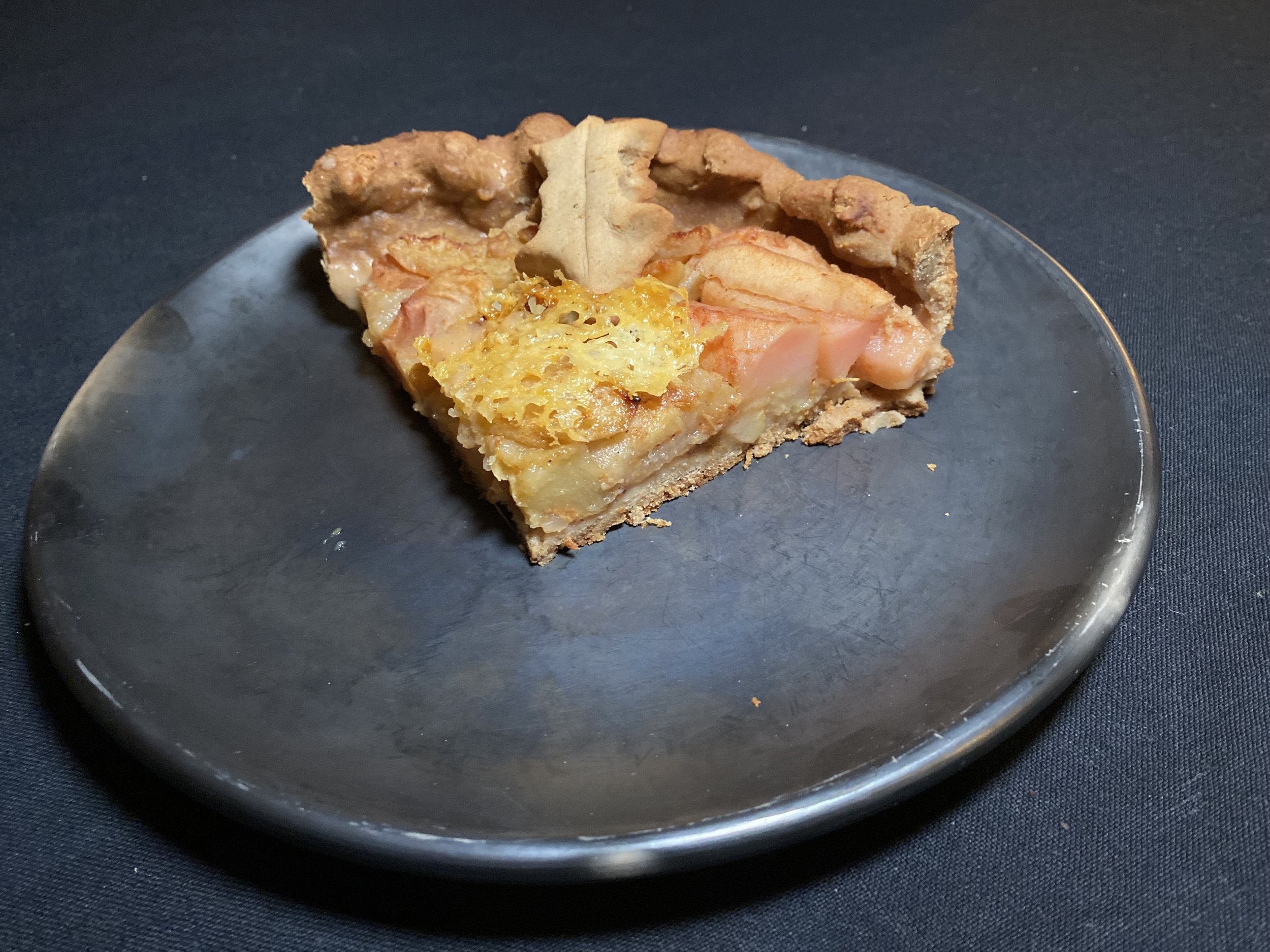Growing up fall meant buying Sara Lee crumb top apple pie. We would have a big slice as dessert with vanilla bean ice cream. Then two days later, a bigger slice of the leftover would be warmed with a slice of cheddar under the broiler for what was my absolute favorite breakfast. The ice cream was nice with the pie, but I always preferred the gooey, salty contrast of the cheese.
My relationship to pie pretty much ended in 2006 when I was diagnoses with multiple food allergy. Baking a gluten-free crust always intimidated me, and all pre-made gluten-free crusts I have ever found contain ingredients I am allergic to also. I suppose my relationship to pie continued as a sense of nostalgia and longing, a sort of deep pie-shaped ache in my belly.
I brought up my love for cheesy apple pie recent conversation with my partner who surprised me by saying he had never heard of this combination. So, I felt determined to introduce him to what I recalled as a wondrous pairing. At the same time, I was fearful— was this actually strange and not at all as good as I recalled?
I turned to google. Don’t others eat this? I mean, apples and cheese are classic cheese plate fare. This lead to some interesting discoveries. Folks were eating apple pie with cheese in 17th century England. Laws in Wisconsin (1935-7) and Vermont (as recent as 199!) actually enforced pie service with cheese (a product of big dairy).
So, now, affirmed that apple pie and cheese is indeed a ‘thing’ I set out to make one. I wanted to incorporate cheese into the pie rather than lay a slice on at the end, as an easing in of my partner to this idea. I was concerned mostly with a good crust, because we all know that is what makes a good pie. I was concerned about toughness and instability. Even though my crust had no issues with gluten developing, I wanted to keep it moist and supple as possible, so I turned to the alcohol in pie crust trick. Liquid is essential to make a crust bind, but too much liquid leads to a soggy crust. Replacing some liquid with alcohol produces a unique result. The alcohol burns off quickly in the cooking process creating a crisp crust while allowing for more pliable dough while working. My gluten-free curst came out like a dream. Whisky offered not only pliability but also some delicious flavor. I turned to my most favorite local producer, Amalga Distillery, whose small batch product has a smoky richness. No surprise whisky, gouda, and apple turns out to be a perfect adult translation of my childhood memories. We ate this pie for dinner, because why not?
whisky cheese crust apple pie
Makes a single crust pie
Ingredients for the curst
1 1/4 cup teff flour
1/2 cup almond flour
1/2 cup oat flour
1/4 cup sorghum flour
2 tablespoons cassava flour or fonio flour
1 teaspoon sugar
1/2 tsp baking powder
3.5 oz cup grated Gouda (about a half cup)
1 tablespoon flaxseed meal
1 teaspoon coconut oil
1 teaspoon vanilla
pinch mace (optional)
2 tablespoons whisky
5-7 tablespoons water to bind
Ingredients for the apple pie filling
about 8 medium apples of different varieties
1 overripe persimmon, peeled and macerated into a liquid
1 tablespoon dark brown sugar
1/2 teaspoon agar powder (optional but helps texture)
1 teaspoon nutmeg
1/2 teaspoon salt
1 tablespoon lemon juice
1 teaspoon fresh grated ginger
Method:
Line a pie pan with parchment.
In a food processor, pulse together the flour, sugar, baking powder, grated cheese, flax, and any spices until you have an even, fine crumb.
Add in the coconut oil, vanilla, and whisky. Pulse.
Add in water 1 tablespoon at a time. Pulse until a loose ball forms. Don’t be too afraid of liquid, and you cannot over mix since this is gluten-free.
Wrap the ball in a damp cloth in a bowl and let hydrate for at least 1 hour on the counter. This dough is easier to roll out at room temperature. Meanwhile, make filling.
In a large bowl, combine the macerated persimmon, sugar, agar, salt, nutmeg, lemon, and ginger to create a slurry. Peel, core, slice your apples. Toss slices in the slurry and let sit.
Preheat your oven to 400F and
After at least one hour, roll out dough between two sheets of parchment. It won’t be quite as pliable as a glutinous dough, so I flip the dough from the parchment onto the pie pan rather than trying to lift it.
Shape your pie dough, using wet hands and don’t be afraid to patch cracks or holes. This dough molds like clay, and you will not make it tough.
Mound in your pie filling, spreading evenly. Cover completely in foil to keep heat in.
Put in the center wrack of the oven. Cook for half an hour at 400F. Then, turn down temperature to 350F and cook for another 45 minutes. Check on the pie and doneness. Continue to cook for about 15 minutes more, depending on crust brownness, without foil. Turn off oven and let sit for at least 15 minutes in the oven. Let cool before serving… maybe with a little more cheese and a little more Almaga whisky!

